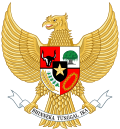First Development Cabinet
The First Development Cabinet[1] (Indonesian: Kabinet Pembangunan I) is the name of the cabinet of the Indonesian government led by President Suharto. This cabinet was announced on 6 June 1968 and served from 10 June 1968 until 27 March 1973. The composition of this cabinet is not much different from the composition of ministers in the Revised Ampera Cabinet. Shortly after the 1971 election, on 9 September 1971, President Suharto announced a reshuffle of the First Development Cabinet and appointed the reshuffled ministers on 11 September 1971. The main tasks of the cabinet, as stipulated in MPRS Decree No. XLI/MPRS/1968 and known as Panca Krida, were:
On 1 April 1969 the implementation of First Pelita (1969–1974) began. The purpose of holding First Pelita is to improve the people's standard of living and at the same time lay the foundations for development in the next stage. While the targets are food, clothing, infrastructure improvement, public housing, expansion of employment opportunities, and spiritual welfare. The focus of First Pelita is the development of the agricultural sector in accordance with the aim of pursuing economic backwardness through the process of reforming the agricultural sector, because the majority of Indonesia's population still lives from agricultural products. Cabinet leader
Cabinet membersMinistersThe following are the ministers of the First Development Cabinet.
Official with ministerial rankThe following are ministerial-level officials in the First Development Cabinet.
ReshuffleOn 9 September 1971, President Suharto made a decision to adjust and replace several Development Cabinet ministers after careful evaluation and consideration. The replacement of several ministers does not imply the formation of a cabinet, but solely to further enhance the implementation of development in the Panca Krida Development Cabinet.[2] Given another assignmentThe ministers who were replaced were given new obligations according to their respective capabilities. Some are members of the Supreme Advisory Council and some are assigned abroad. This replacement will actually improve the implementation of the Development Cabinet's tasks. So most of the ministers who were appointed were those who from the beginning took part in carrying out Government policies, particularly in the economic and development fields. Thus, it is hoped that the continuity of the policies outlined for the smooth implementation of the Development Cabinet's duties will be more guaranteed. Reshuffle Cabinet appointmentsThe inauguration was held on Saturday, 11 September 1971. Notes
ReferencesBook
Newspapers and others |
||||||||||||||||||||||||||||||||||||||||||||||||||||||||||||||||||||||||||||||||||||||||||||||||||||||||||||||||||||||||||||||||||||||||||||||||||||||||||||||||||||||||||||||||||||||||||||||||||||||||||||||||||||||||||||||||||||||||||||||||||||||||||||||||||||||||||||||||||||||||



















































